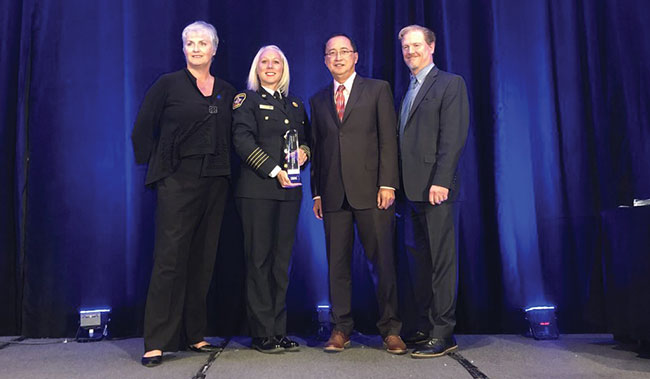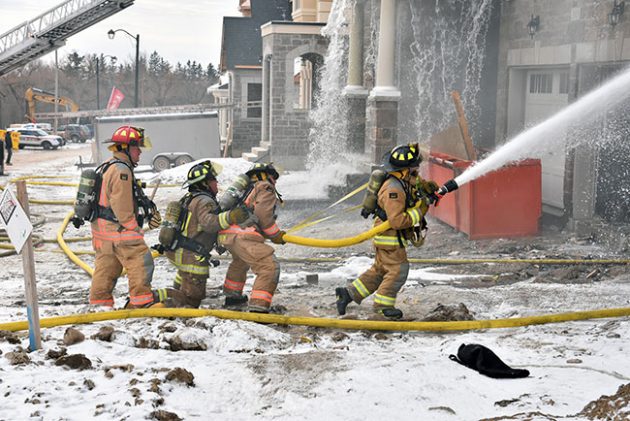
Features
Use data to drive decision-making
Vaughan Fire and Rescue Service embarked on an ambitious data project that gained national recognition
October 30, 2019
By Deryn Rizzi
 The completed project, titled Igniting Insight: Using Geographic Information Systems (GIS) and Analytics in the Fire Service, received the bronze 2019 Innovative Management Award from the National Institute of Public Administration of Canada (IPAC). From left to right: Beth Bell (IBM Canada, vice-president, enterprise and commercial Canada), Chief Deryn Rizzi (Vaughan Fire & Rescue Service), Professor Adriano O. Solis (York University) and Scott Thompson (CEO, Institute of Public Administration of Canada)
The completed project, titled Igniting Insight: Using Geographic Information Systems (GIS) and Analytics in the Fire Service, received the bronze 2019 Innovative Management Award from the National Institute of Public Administration of Canada (IPAC). From left to right: Beth Bell (IBM Canada, vice-president, enterprise and commercial Canada), Chief Deryn Rizzi (Vaughan Fire & Rescue Service), Professor Adriano O. Solis (York University) and Scott Thompson (CEO, Institute of Public Administration of Canada)
Some of the most important tools for fighting fires include advanced protective gear and state-of-the-art suppression equipment. But, in an age of growing communities, density issues and complex urban and rural landscapes, one of the most valuable tools in fire fighting is data.
Based in the city of Vaughan, Ont., with a population of more than 335,000, Vaughan Fire and Rescue Service (VFRS) strives to operate as efficiently and effectively as possible while maintaining what is most important: the safety of firefighters and those who live in, work in and visit the city.
As a leader in the industry, it is our responsibility to enhance our understanding of the needs of our growing city. We seek forward-looking analytic techniques to create greater value for citizens and the community through data-driven decision-making.
■ Setting the direction
In May 2019, VFRS developed a Master Fire Plan to set the direction of the service for the next 10 years. The detailed plan contains maps, charts and data; however, there were some gaps in using the data to fully understand the future development of the city and the resources required to keep pace. This problem indicated a need to develop tools that could properly determine and forecast operational capacity.
To address this issue, VFRS partnered with York Region, York University, the University of Calabria, Universidad Autónoma del Estado de México, and the University of Genoa to undertake a project in innovation that would:
- Use shared data to create community profiles to understand risks within the city and the vulnerability index.
- Map a future state of the municipality and current resources to develop predictive analytics.
- Model and simulate VFRS’s response to emergencies to gain an in-depth analysis of response times and other key performance indicators.
- Use data-driven, evidence-based decision-making to determine fire station locations and allocation of resources.
■ Using data for the future
VFRS worked with its municipal partner, York Region, to learn about the techniques and tools that could drive insight from data. The team looked at historical response-time data, building permits, population data, present road networks and planned road extensions. From there, travel-time models for each fire station were generated using different scenarios. The response coverage for each scenario factored in the number of properties and population that could be reached as well as other key criteria, including vulnerable populations and areas that have been identified as difficult to access. Ultimately, an interactive decision support tool was created. The tool helps VFRS make decisions about station placement, resource allocation and road network improvements.
■ Evaluating performance through simulation
To undertake the second part of their project, VFRS partnered with York University’s Advanced Disaster, Emergency and Rapid Response Simulation (ADERSIM) team in the School of Administrative Studies, in collaboration with the Modelling and Simulation Center – Laboratory of Enterprise Solutions (MSC-LES) of the University of Calabria. This part was two-fold: to conduct a statistical analysis of the VFRS incident database (covering records since January 2009), and to undertake modelling and simulation of VFRS’s response to emergencies. VFRS sought to answer these questions:
- Is the current assignment of apparatus/crews operationally adequate and efficient?
- Is there a need to increase responding units at any station or to reallocate existing ones to other stations?
- Would it be appropriate for VFRS to consider building additional fire stations?
The modelling and simulation framework involved two different simulation models running on separate platforms. The Incident Generation Engine simulates the arrival to emergency incidents. The Response Simulation Model is an agent-based simulation model that receives inputs from the first model.
The objective was to use modelling and simulation technology to evaluate the expected operating performance and efficiency of the VFRS system (stations, vehicles and fire fighting crews), taking into consideration the uncertainties of emergencies (e.g. time and geographic location of the event, type of incident, alarm processing, vehicle turnout time and on-scene time, among other relevant variables).

The modelling has allowed VFRS to determine optimal unit availability and ideal station and truck placement to have a positive impact on response times, which can ultimately reduce property damage and save lives. PHOTO BY VFRS
■ Gaining insight from data
For 18 months, VFRS worked with York University on the modelling and simulation. VFRS provided historical data and operational procedures/protocols, as well as reviewed the simulation model and preliminary results with the researchers and offered input into required adjustments. In particular, VFRS validated some of the basic assumptions made in the model and the initial simulation results. This enabled the researchers to better identify statistics and operational parameters to build and refine the model as needed.
Interpreting and using data is necessary for fire service management. Decisions on a wide range of critical issues, such as funding, apparatus purchases, station placement, and staffing, are validated using data obtained from a wide variety of sources. We have developed predictive, spatial and prescriptive methods to segregate, organize and model the data to draw conclusions and identify patterns. We used math, statistics and modelling along with creativity and skepticism to ask the right questions, explore data and distill it down to insights that support our most critical decisions while reducing costs, improving efficiencies and mitigating risks.
The modelling and simulation tool was used to examine response performance. Results from the simulation have led VFRS to better evaluate community risks and consider improvements in its operations. The modelling has allowed VFRS to determine optimal unit availability and ideal station and truck placement to have a positive impact on response times, which can ultimately reduce property damage and save lives.
■ Award-winning work
The completed project, titled Igniting Insight: Using Geographic Information Systems (GIS) and Analytics in the Fire Service, received the bronze 2019 Innovative Management Award from the National Institute of Public Administration of Canada (IPAC). Launched in 1990, the Innovative Management Award recognizes government organizations that have shown exceptional innovations that address the wide variety of issues facing society today. It celebrates the ability of public servants across the country to transform public administration, advance knowledge of management systems and structures, and improve transparency, accountability and responsiveness while increasing public participation.
■ Commitment to innovation
VFRS’s use of data and smart technology aligns with the City of Vaughan’s overall commitment to innovation and continuous improvement. In January 2016, Vaughan became the second municipality in Canada to be World Council on City Data ISO 37120 Platinum Certified and will be the first city to pilot the new Smart Cities standard ISO 37122.
“Vaughan continues to elevate its reputation as a trusted and sought-after Smart City technology leader. We remain committed to working with Vaughan Fire and Rescue Service to develop innovative solutions that ultimately improve the human condition for all people,” said Maurizio Bevilacqua, mayor for the City of Vaughan.
The success of this project lies in the ability of VFRS to use data to identify the impact of any resource allocation or infrastructure change on performance and response times – two factors that are paramount when responding to an emergency. This will help ensure the fire service is strong, resilient and well-positioned for the future.
Deryn Rizzi is the fire chief of the Vaughan Fire and Rescue Service. Chief Rizzi completed a Bachelor of Education and Bachelor of Arts from Queen’s University. She graduated from York University with a Masters of Arts (Disaster and Emergency), holds a Masters Certificate in Municipal Leadership from the Schulich School of Business and is completing a PhD at York University. Contact Deryn at deryn.rizzi@vaughan.ca or follow her on Twitter at @derynrizzi.
Print this page
Advertisement
- 5 Reasons you should consider meditation
- Leadership Forum: Social media followers don’t make a leader